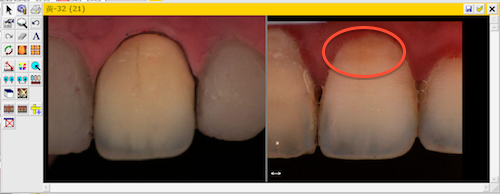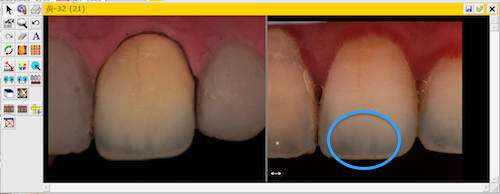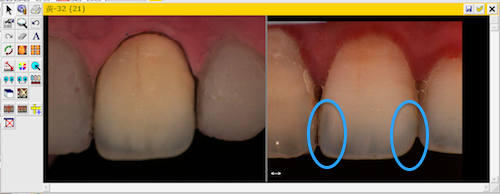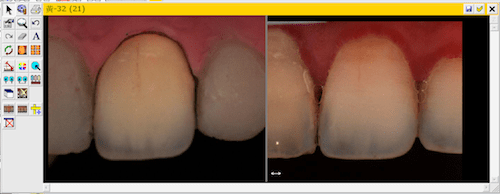
Tof promised to write something about shade matching/ shade verification regarding manufacturer part, but I was so busy on my works. As a result, I was short to make delivery of my promise by this article.
Actually in this post, it is mainly to make discussion with everyone on what should be taken into consideration while purchasing a shade matching device – the functions which should be thought about. To put it simply, which brand name you should choose from.
Before getting started, tof would still like to make a restatement here about who would require a shade matching spectrophotometer to work on the shade verification process (If you have no ideas about what shade verification is, please read this article or this article) (no English version yet for these two articles).
Here below let’s look at the differences first.
When applying the shade verification procedure, it may enable the shade of the ceramic crown you made to reach 85% accuracy/satisfaction. If you are still not satisfied, you can try a second shot in order to get extra points for your work to 90 or 95 percents.
Without a shade verification procedure, your dental technician may have to make you tryin a crown three times in patients’ mouth and can still not reach 85 percent matching in shade. This is to say that if you are really serious about the aesthetics of anterior teeth or you are already a master of the aesthetics dentistry, you should and must apply the shade verification procedure. By doing so, you will be able to save tremendous time for you and your patient and increase your patient satisfaction.
If we would to categorize shade-matching devices, they can be simply divided into two major types:
Complete Tooth Surface Measurement (CTSM) type: the measurement includes gingival (gum) and the whole surface of one crown.
Limited Tooth Surface Measurement (LTSM) type: the measurement is only limited to partial areas (most of the parts are limited to a round area with a radius of 3mm or 5mm.)
If your goal is to have a device to work on simple shade matching procedures, I believe that there is no doubt any shade matching device is able to fit such requirements. However, if you actually need to take advantage of the most important function of a shade matching device – the shade verification procedure, then LTSM type shade matching devices won’t do the work for you at all. With a range of 3mm or 5mm radius is insufficient for a technician to interpret shade and confirm the match of shade on his/her ceramic works.
Another reason why a LTSM type shade matching device is not in the first instance is: for the verification of the accuracy of a ceramic crown, other than shade data, shade characterization should also be checked. So what is “shade characterization”?
Please take a look at the first picture in this article, and the depicted crown was a finished work by a well-known domestic dental technician on his(her) third try without using the techniques of shade verification (in other words, tof’s this patient has come three times for this crown due to shade mismatch).
Does everyone feel that the tooth #21,a full ceramic crown shown on the left hand side and #11 natural tooth (already flipped horizontally from left to right) shown on the right hand side, are they alike? For me, I believe that there are still a lot of rooms for improvements.
Let’s take a look first on the part of natural tooth #11(right hand side in the below picture), on the cervical of the tooth, there was an orange patch. The dental technician failed to duplicate such feature.

Next, the depth of mamelon on incisal third was also not correct:
Let alone to say that the mesial and distal incisal edge transparency was both missing.
However, have you noticed something here? The technician did actually imitate the crack line! So to simply put, if the technician had done the procedure of shade verification, a crown like that should not be sent back to the clinician in the first place. That is to say, in the dental laboratory, the technician is supposed to make sure that all of these features are faithfully duplicated. In other words, for the things we have mentioned above as “orange patch”, “depth of mamelon”, “transparency layer” and “crack line”, they are the “shade characterization”. In fact, the verification on these shade characterization is probably more important than the verification on shade data. (tof would like to mention about this part in more details in the future, but we will put a stop here now!)
Hence, for the LTSM type shade matching devices which are not able to do verification on “shade characterization” (because it only see 3 mm surface of a crown), let’s say bye bye to them (however, as tof has put emphasis on it once, if you purpose is to make simple shade matching, you can still use this type of shade matching devices due to their cheaper price tag).
Now our option is only left with the “CTSM” ones, the next idea to take into consideration is, of course, the accuracy part of the equipment. Let’s see if there is any study for reference (the following two paragraphs are related to academic fields. It’s possibly a little boring, so if you are not interested in, just skip them.)
In 2009, Kim-Pusateri S studied both the reliability and the accuracy of the following four types of shade matching devices:
SpectroShade (European version of Shadepilot)
ShadeVision
VITA Easyshade (LTSM type)
ShadeScan
Simply speaking, the results are that Shadepilot is with a quite high ranking for the actual experiment outcomes of both reliability and accuracy.
In 2010, Karl Martin Lehmann tested both the repeatability and accuracy of four kinds of shade matching devices:
VITA Easyshade
VITA Easyshade compact
Degudent Shadepilot
X-Rite Shadevision
With their findings, the accuracy of Shadepilot is higher than two other single point measurement machines of VITA, and for anyone who is interested in these articles, he/she can look up the them for further readings.
So, it’s pretty obvious that why tof chooses Shadepilot. If you really concerns about the accuracy of any device, in my opinion, I believe that if you are able to use a shade matching device with correctness and familiarity, you should not be concerned too much over the accuracy problem. In this way, it would be more meaningful to focus on the options of functionality.
Returning again to what tof has mentioned previously, if you would only like to use shade-matching devices for simple shade matching, you may just try on any shade-matching device as you like. However, if you expect that your technician can verify crown shade before he/she deliver crowns to your office, you must make a decision here. LTSM type of machine just can’t do the work.
To perform shade verification on ceramic crowns, there is a very important prerequisite between the doctors and the technicians. Only when they both use the same shade matching device can their data be compared/matched/verified. What does this mean? It means that if I need to buy a shade matching device, I would buy the one which is already the most popular. For that, I will be speaking the same language in shade data with most of the best technicians in the world, because we all use the same devices.
In “The Little Book That Builds Wealth” by Pat Dorsey, one of the sustained competitive advantages, “the network effect”, is mentioned. In summary, with a assumption that if there are more people using a product, there will even more people to be attracted to (or forced to) using it. Otherwise, the problem of “language barrier” mentioned above will occur (For example, most people use the software Office from Microsoft, in order for you to work with the same formats as most of the others, you are certainly to follow and use the Office software), that’s how Microsoft made a big fortune. Therefore, if I were a manufacturer of any shade matching device, I would immediately lower my product price to gain the best market shares I can get. Afterwards, when my market shares were up to a certain degree, I would no longer have to be worried about the other competitors. On the basis of the same quality and price, customers would surely choose my product, right?
With my understandings from secondary sources, there are about over one hundred Shadepilot machines in the country (Taiwan), counted as high on its market shares. The thing I feel sorry about is that many dental technicians use Shadepilot as a marketing tool rather then due to their unfamiliarity with its application. It’s such a pity. I recommend all you technician fellows out there, both of the shade-matching device and shade verification procedure can lead you to better master your techniques of porcelain buildup (you can refer to this article-xxx). As a result, if there is anyone appears to you for purchasing your used Shadepilot, which is already covered with dust on the deck, please remember not to sell it in any way… (only if the person who came up to you call himself tof, then maybe you should think about the offer, truly. Anyhow you won’t and haven’t use it for a long time, why don’t you sell it to me, right?!)
<The end>

No responses yet